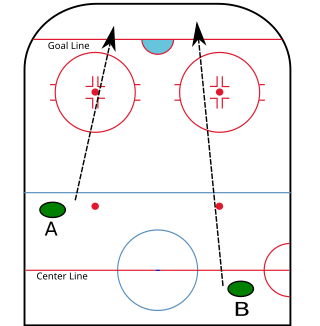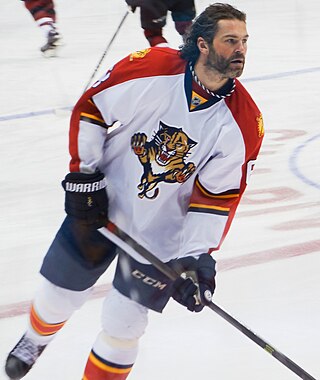Related Research Articles

Ice hockey is a team sport played on ice skates, usually on an ice skating rink with lines and markings specific to the sport. It belongs to a family of sports called hockey. In ice hockey, two opposing teams use ice hockey sticks to control, advance, and shoot a closed, vulcanized, rubber disc called a "puck" into the other team's goal. Each goal is worth one point. The team which scores the most goals is declared the winner. In a formal game, each team has six skaters on the ice at a time, barring any penalties, one of whom is the goaltender. Ice hockey is a full contact sport, and is considered to be one of the more physically demanding team sports.

In many team sports, defense or defence is the action of preventing an opponent from scoring. The term may also refer to the tactics involved in defense, or a sub-team whose primary responsibility is defense. Similarly, a defense player or defender is a player who is generally charged with preventing the other team's forwards from being able to bear down directly on their own team's goalkeeper or goaltender. Such positions exist in association football, ice hockey, water polo and many other sports.

In ice hockey, a goal is scored when the puck entirely crosses the goal line between the two goal posts and below the goal crossbar. A goal awards one point to the team attacking the goal scored upon, regardless of which team the player who actually deflected the puck into the goal belongs to. Typically, a player on the team attempting to score shoots the puck with their stick towards the goal net opening, and a player on the opposing team called a goaltender tries to block the shot to prevent a goal from being scored against their team.
Short-handed is a term used in ice hockey and several related sports, including water polo, and refers to having fewer players on the ice during play, as a result of a penalty. The player removed from play serves the penalty in the penalty box for a set amount of time proportional to the severity of the infraction. If a goaltender commits a minor infraction, another player who was on the ice at the time of the penalty serves, often but not necessarily the team captain.

In ice hockey, icing is an infraction when a player shoots, bats with the hand or stick or deflects the puck over the center red line and the opposing team's red goal line, in that order, and the puck remains untouched without scoring a goal. The rule's main purpose is preventing a defending team from delaying the game by, relatively easily, sending the puck to the other side of the rink.

The centre in ice hockey is a forward position of a player whose primary zone of play is the middle of the ice, away from the sideboards. Centres have more flexibility in their positioning and therefore often end up covering more ice surface than any other player. Centres are ideally strong, fast skaters who are able to backcheck quickly from deep in the opposing zone. Generally, centres are expected to be gifted passers more so than goal scorers, although there are exceptions - typically larger centres who position themselves directly in front of the net in order to score off rebounds. They are also expected to have exceptional "ice vision", Hockey IQ, intelligence, and creativity. They also generally are the most defensively-oriented forwards on the ice, as they are expected to play the role of the third player in defense, after the defencemen. Centres usually play as part of a line of players that are substituted frequently to keep fresh and keep the game moving.
In ice hockey, a forward is a player, and a position on the ice, whose primary responsibility is to score and assist goals.

Winger, in the game of ice hockey, is a forward position of a player whose primary zone of play is along the outer playing areas. They typically flank the centre forward. Originally the name was given to forward players who went up and down the sides of the rink. Wingers generally have the least defensive responsibilities out of any position on the ice, however they are still tasked with defensive duties such as forechecking duties or covering the point in the defensive zone.

Defence or defense in ice hockey is a player position that is primarily responsible for preventing the opposing team from scoring. They are often referred to as defencemen, D, D-men or blueliners. They were once called cover-point.

A penalty in ice hockey is a punishment for an infringement of the rules. Most penalties are enforced by sending the offending player to a penalty box for a set number of minutes. During the penalty the player may not participate in play. Penalties are called and enforced by the referee, or in some cases, the linesman. The offending team may not replace the player on the ice, leaving them short-handed as opposed to full strength. When the opposing team is said to be on a power play, they will have one more player on the ice than the short-handed team. The short-handed team is said to be "on the penalty kill" until the penalty expires and the penalized player returns to play. While standards vary somewhat between leagues, most leagues recognize several common varieties of penalties, as well as common infractions.

The neutral zone trap is a defensive strategy used in ice hockey to prevent an opposing team from proceeding through the neutral zone and to force turnovers.
The point is a term in ice hockey to indicate a position inside the opposition's blue line along the edges of the rink.
In sports, a utility player is one who can play several positions competently. Sports in which the term is often used include association football, basketball, American football, baseball, rugby union, rugby league, softball, ice hockey, and water polo.

Roller in-line hockey, American roller hockey or inline hockey, is a variant of hockey played on a hard, smooth surface, with players using inline skates to move and ice hockey sticks to shoot a hard, plastic puck into their opponent's goal to score points. The sport is a very fast-paced and free-flowing game and is considered a contact sport, but body checking is prohibited. There are five players including the goalkeeper from each team on the rink at a time, while teams normally consist of 16 players. There are professional leagues, one of which is the National Roller Hockey League (NRHL). While it is not a contact sport, there are exceptions, i.e. the NRHL involves fighting.

In sports, a starting lineup is an official list of the set of players who will participate in the event when the game begins. The players in the starting lineup are commonly referred to as starters, whereas the others are substitutes or bench players.

Ivan Boldirev is a Yugoslavian-born Canadian former professional ice hockey player. Boldirev played fifteen seasons and over 1000 games in the National Hockey League from 1970 through 1985. He featured in the 1982 Stanley Cup Finals with the Vancouver Canucks. Boldirev was noted during his career as one of the sport's best stickhandlers.

In American football, the specific role that a player takes on the field is referred to as their "position". Under the modern rules of American football, both teams are allowed 11 players on the field at one time and have "unlimited free substitutions", meaning that they may change any number of players during any "dead ball" situation. This has resulted in the development of three task-specific "platoons" of players within any single team: the offense, the defense, and the so-called 'special teams'. Within these three separate "platoons", various positions exist depending on the jobs that the players are doing.

A comparison of American football and rugby union is possible because of the games' shared origins, despite their dissimilarities.
This is a list of common terms used in the sport of ice hockey along with the definitions of these terms.

Sports strategy refers to the numerous sets of methods applied in various sports in order to find ways and create advantageous methods for achieving an outcome of success. For team sports, strategy largely consists of how to coordinate the internal movements and positioning of players in a team. For individual sports, strategy is based on advantages that can be found in various available options for the player.
References
- ↑ Hans Hetrick (September 2018). Stathead Hockey: How Data Changed the Sport. Capstone. p. 37. ISBN 978-1-5435-1450-6.
- ↑ Skahan, Sean (February 17, 2016). Total Hockey Training. Champaign, IL: Human Kinetics. p. 20. ISBN 978-1-4925-0709-3 . Retrieved September 6, 2022.
- ↑ Shorey, John (2004). Hockey Made Easy (6th ed.). Brockville, ON: John Shorey. p. 80. ISBN 0-9680461-0-X . Retrieved September 6, 2022.
- Sean Skahan (17 February 2016). Total Hockey Training. Human Kinetics. pp. 19–. ISBN 978-1-4925-8532-9.<